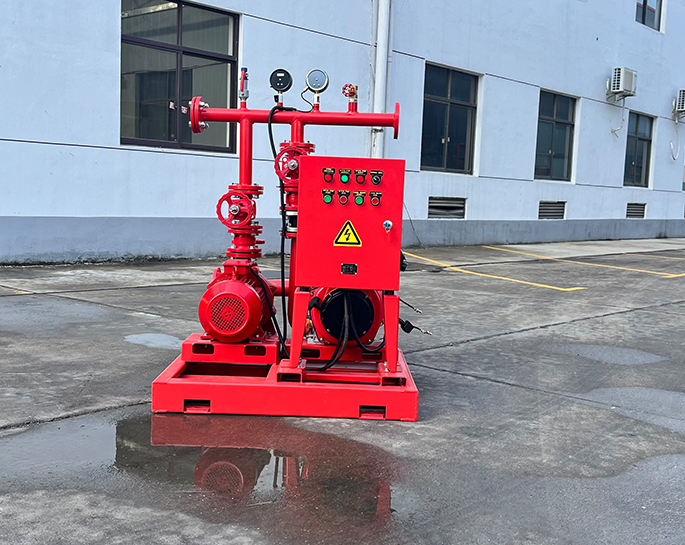What are the best practices for testing electric fire pumps to ensure they are in proper working condition?
Mar 27, 2024
Share:
Testing electric fire pumps is critical to ensure they are in proper working condition in case of emergencies. Here are some best practices for testing electric fire pumps:
1. **Follow Manufacturer's Guidelines**: Adhere strictly to the manufacturer's instructions and recommendations for testing the specific make and model of the electric fire pump. These guidelines often provide detailed steps for testing procedures and frequency.
2. **Regular Testing Schedule**: Establish a regular testing schedule for the electric fire pump. This schedule should comply with local regulations, codes, and standards (e.g., NFPA 25).
3. **Perform Routine Visual Inspections**: Before testing, visually inspect the pump, motor, wiring, and control panel for any signs of damage, corrosion, leaks, or loose connections. Ensure that all components are clean and free from obstructions.
4. **Test Run with No Water Flow**: Conduct a monthly test run with no water flow to check the pump's ability to start, run, and reach the required speed. Monitor for any unusual noises, vibrations, or fluctuations in voltage or current.
5. **Flow Test**: Conduct an annual flow test to ensure the pump can deliver the required water flow rate as per design specifications. This involves flowing water through the system and measuring flow rates at various points, including at the discharge.
6. **Pressure Test**: Perform an annual pressure test to verify that the pump can achieve and maintain the necessary pressure levels. This test involves closing the discharge valve to build pressure within the system and monitoring for pressure stability over time.
7. **Record Keeping**: Maintain comprehensive records of all tests, including dates, test results, any issues identified, and actions taken to address them. Documentation is essential for compliance purposes and to track the pump's performance over time.
8. **Emergency Power Supply Test**: If the electric fire pump relies on an emergency power supply (e.g., generator), regularly test the backup power source to ensure it can activate and supply power to the pump during power outages.
9. **Training and Personnel**: Ensure that personnel responsible for testing electric fire pumps are adequately trained and competent to perform the tests safely and effectively. They should understand the equipment, testing procedures, and safety protocols.
10. **Emergency Procedures**: Establish clear procedures for responding to any failures or abnormalities detected during testing. This includes protocols for shutting down the pump, addressing immediate safety concerns, and initiating repairs or maintenance as needed.
11. **Consultation with Experts**: If unsure about any aspect of testing or maintenance, consult with qualified engineers, technicians, or fire safety professionals for guidance and assistance.
By following these best practices, you can help ensure that electric fire pumps are maintained in optimal condition and ready to perform effectively in the event of a fire emergency.

1. **Follow Manufacturer's Guidelines**: Adhere strictly to the manufacturer's instructions and recommendations for testing the specific make and model of the electric fire pump. These guidelines often provide detailed steps for testing procedures and frequency.
2. **Regular Testing Schedule**: Establish a regular testing schedule for the electric fire pump. This schedule should comply with local regulations, codes, and standards (e.g., NFPA 25).
3. **Perform Routine Visual Inspections**: Before testing, visually inspect the pump, motor, wiring, and control panel for any signs of damage, corrosion, leaks, or loose connections. Ensure that all components are clean and free from obstructions.
4. **Test Run with No Water Flow**: Conduct a monthly test run with no water flow to check the pump's ability to start, run, and reach the required speed. Monitor for any unusual noises, vibrations, or fluctuations in voltage or current.
5. **Flow Test**: Conduct an annual flow test to ensure the pump can deliver the required water flow rate as per design specifications. This involves flowing water through the system and measuring flow rates at various points, including at the discharge.
6. **Pressure Test**: Perform an annual pressure test to verify that the pump can achieve and maintain the necessary pressure levels. This test involves closing the discharge valve to build pressure within the system and monitoring for pressure stability over time.
7. **Record Keeping**: Maintain comprehensive records of all tests, including dates, test results, any issues identified, and actions taken to address them. Documentation is essential for compliance purposes and to track the pump's performance over time.
8. **Emergency Power Supply Test**: If the electric fire pump relies on an emergency power supply (e.g., generator), regularly test the backup power source to ensure it can activate and supply power to the pump during power outages.
9. **Training and Personnel**: Ensure that personnel responsible for testing electric fire pumps are adequately trained and competent to perform the tests safely and effectively. They should understand the equipment, testing procedures, and safety protocols.
10. **Emergency Procedures**: Establish clear procedures for responding to any failures or abnormalities detected during testing. This includes protocols for shutting down the pump, addressing immediate safety concerns, and initiating repairs or maintenance as needed.
11. **Consultation with Experts**: If unsure about any aspect of testing or maintenance, consult with qualified engineers, technicians, or fire safety professionals for guidance and assistance.
By following these best practices, you can help ensure that electric fire pumps are maintained in optimal condition and ready to perform effectively in the event of a fire emergency.


.png)
.png)

.png)


